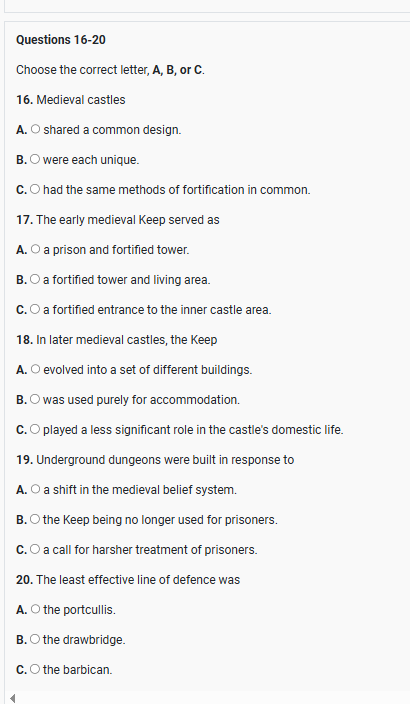
IELTS LISTENING Layout of a Medieval English Castle listening practice test has 10 questions.
Today we are going to study the typical layout of a medieval English castle. Highly fortified and with difficult access, medieval castles were Impressive strongholds, designed to keep the castle’s inhabitants safe and the invaders at bay.
Audio Player
The main entrance Would have been the Outer Gatehouse, located at the bottom right-hand corner of the diagram, just by the Q11 chapel buildings. However, even If you had entered via the Outer Gatehouse into the castle grounds, you would still have been outside the main part of the castle. The buildings in the Outer Court were not the main residential areas of the castle. These latter buildings belonged to the inner castle area and were heavily protected both by a water-filled channel known as a ‘moat’ which extended around a third of the inner part of the castle as well as the fortified walls around the castle exterior.
To enter the Innermost area you had to enter a long, narrow tunnel known as a barbican, over, and directly above which, the Gatehouse was located. The barbican, being the only access point to the inner castle, was narrow and heavily guarded to prevent large enemy forces storming the inner castle area, The inner castle area held the main buildings around which daily life revolved. Here the Q12 Great Hall, along, with the Q13 Great Chambers and Kitchens were located, as well as the castle Q14 Bakehouse. The Great Hall was the only building with a courtyard view to the back and front. Whilst the Great Hall enjoyed a central location in the inner castle area, the Great Chambers and Kitchen were less prominently positioned. Both of the latter buildings were located off to either side of the Great Hall. The Great Chambers, unlike the Bakehouse. which is next to one of the towers, did not enjoy a courtyard view. Part of the exterior castle wall formed the back wall of the Great Chambers as it did with the Q15 Stables, located in the Outer Court.

The layout I have just described will give you a Q16 better idea as to the design of a medieval castle. There was no blueprint for castles though and the design and layout of each castle was determined greatly by local demands, function, and purpose for which the fortification was intended. What we see in the castle design here is an advance on earlier medieval designs. Those medieval castles that predated this one had very basic residential and living areas.
In such castles, the main focal point was the Keep rather than the Great Hall and Great Chambers, as In later years. Q17 Little more than a fortified tower, the Keep doubled up as basic accommodation for the castle’s residents. As the years passed, the living areas became more luxurious, evolving into separate buildings. Confusingly, the Keep was known as a ‘don geon’, meaning fortified tower in French. The term ‘dungeon’ was only used in later years to refer to underground prisons. In fact, at the time when the Keep dominated castle affairs, the use of latter-day dungeons for imprisonment was an unknown and alien concept, the judicial systems favouring more physical forms of punishment instead. Another dissimilarity between earlier and later medieval castles was In their fortification. A moat, fortified walls, and a barbican were typical features of most castles. However, it was recognised with the passage of time that the narrow, fortified entrance of the Q20 barbican was insufficient defence against an enemy intent on invading the castle. As a result, extra, more reliable fortifications were added in the form of a portcullis and a drawbridge. The portcullis was a spiked metal gate that could be dropped vertically down from under the gatehouse, thereby sealing off the inner castle entrance from the outside world. To protect the main castle entrance further, a drawbridge was placed in front of the portcullis. This was a retractable bridge between the gatehouse and the outside area of the castle. However, the portcullis always remained the last line of defence against the enemy.
Best Results Easily Get Required Score IELTS Exam Dates Available, Small Batch Size with Flexible Time, Professional.
![]()
8439000086
8439000087
7055710003
7055710004
IELTS Simulation 323 GMS Road, Near Ballupur Chowk, Dehradun, India
![]()
email: info at ieltsband7.com
Boost Your Score: Practice IELTS Online with IELTS Simulator Prepare for IELTS Effectively Using IELTS Simulator Ace the IELTS: Try Realistic Practice on IELTS Simulator IELTS Simulator: Online Practice to Improve Your IELTS Score Rocky Bay field trip listening practice test has 10 questions belongs to the Leisure & Entertainment subject. Prepare for IELTS IELTS Test International Experienced Teacher Best Training By CELTA Trainer. Best Results Easily Get Required Score IELTS Exam Dates Available, Small Batch Size with Flexible Time, Professional. Easily Get Required Score I am interested in IELTS Pass with Confidence, Dehradun Small Batch Size with Flexible Time, professional faculty. Learn From Experienced Teacher Best IELTS Coaching Dehradun Best IELTS in Dehradun Uttarakhand GMS Road BEST coaching in Dehradun Apply for Class Courses Today Good Results. Small Batch Size, Flexible Time and Professional IELTS Teacher Best IELTS coaching classes IDP certified British Council trained and CELTA certified experienced trainer. Easily Get Required Score Tel:8439000086 Tel:8439000087 Tel:7055710003 Tel:7055710004 Tel:7055710009